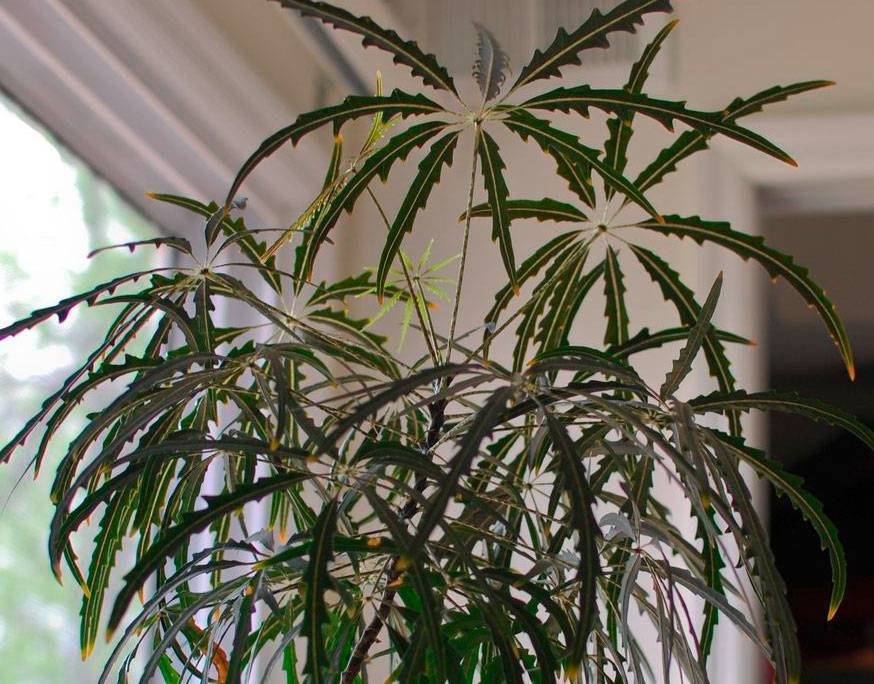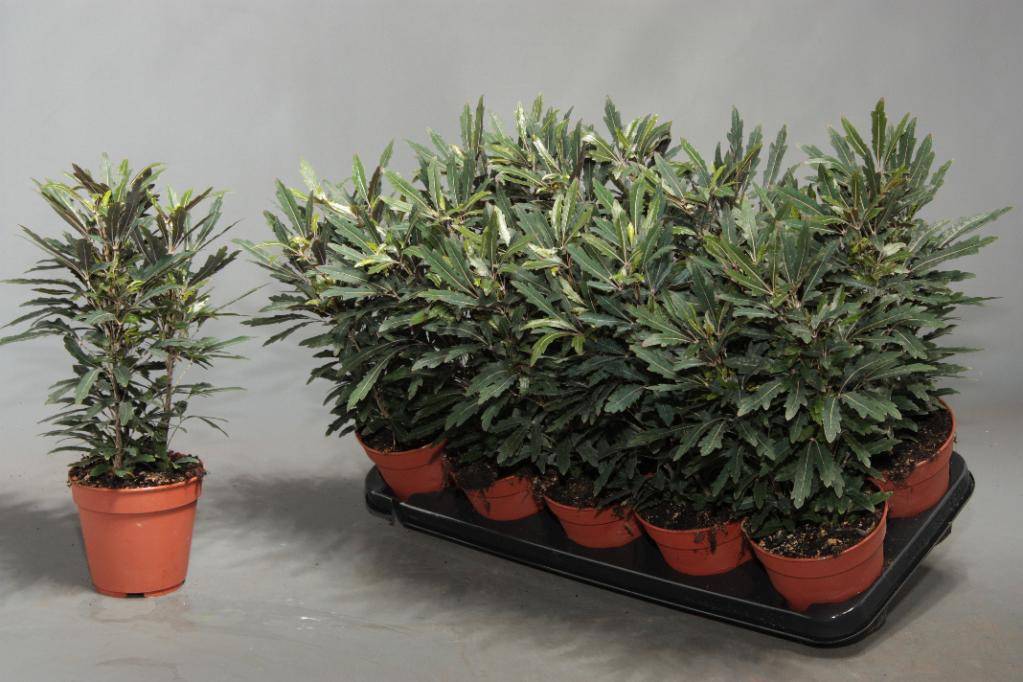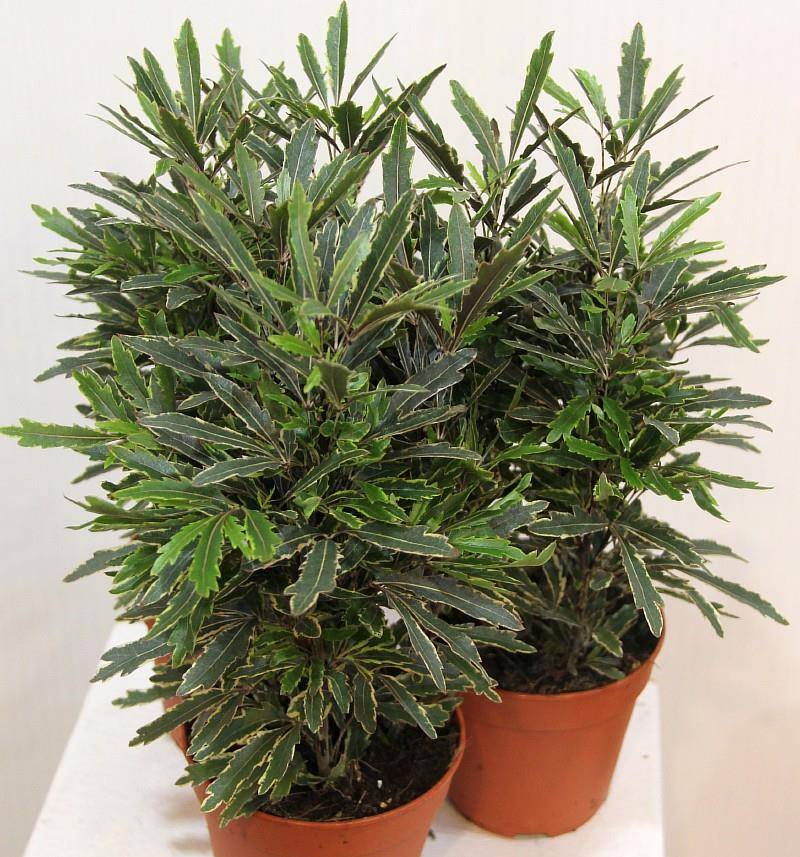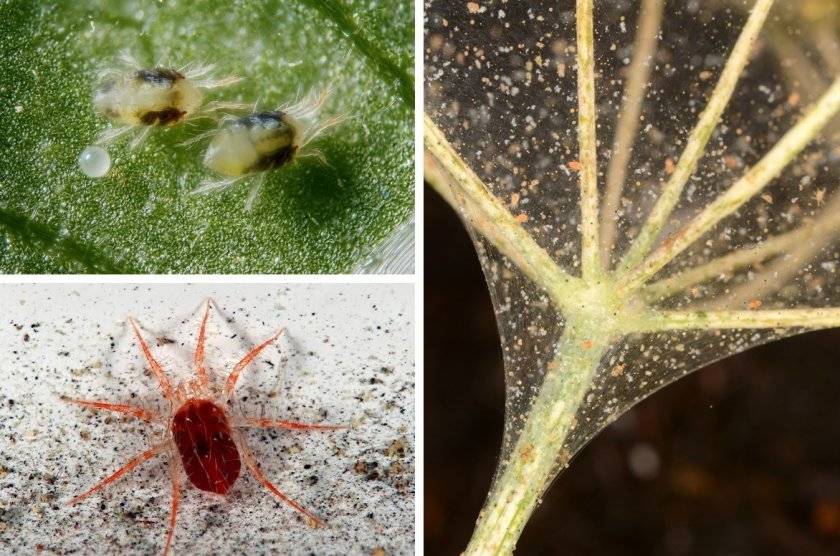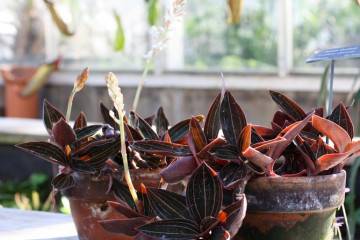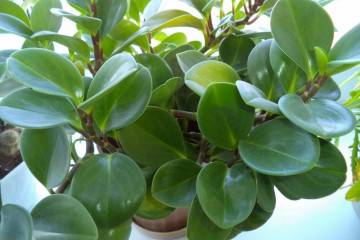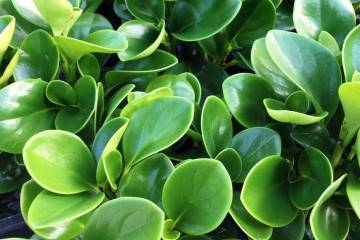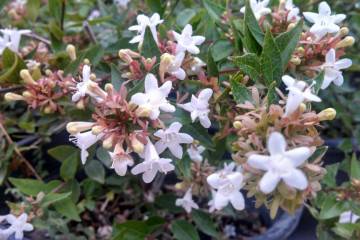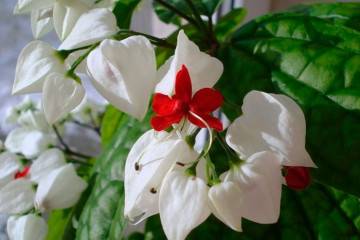Dizigoteka: home care and main varieties
Content:
The dizigoteka flower looks unusual and beautiful. The narrow serrated leaves immediately attract attention. Such a plant is rarely found in apartments, since it is difficult to care for it.
Main types
The dizigoteka plant is represented by different varieties. Each of them has its own characteristics. In nature, there are more than 100 species, but only some of them are adapted to domestic conditions.
Dizigoteka elegantissima
The most common type. Differs in complex serrate leaves, which are located on long petioles. On one branch there are up to 11 leaves of an elongated narrow shape. They have serrated edges.
It blooms rarely, the inflorescences are collected in umbrellas, which are white in color. They look inconspicuous and unobtrusive.
Dizigoteka Bianca
The leaves are dark green with purple veins. Irregular cream-colored edging trims the edges. All this gives the plant a variegated appearance. The leaf blade rarely exceeds 9 cm in length and 1.5 cm in width. The edges are serrated with slightly smoothed apices.
Dizigoteka graceful
Grows up to 2 m in height. Leaves are long, narrow, collected in umbrellas of 11 pcs. It branches poorly, usually most of the leaves are at the top of the tree.
Other species and varieties
Dizygoteka Castor is distinguished by yellowish-white veins on the leaves. They consist of three segments and rarely exceed 9 cm in length.
The Zhemani variety is distinguished by wide leaves up to 3-4 cm, and the length of the plate reaches up to 5 cm. The central vein is reddish, the teeth are of the same shade.
Dizigoteka Veyche is distinguished by smooth edges of leaves, which grow up to 4 cm wide. The description of the Kerkhova variety does not differ from Veyche, only this species has a paler color.
Dizigoteka: home care
Many novice gardeners like the elegantissima dizigoteka. Caring for a plant at home requires special conditions.
Watering
The plant is watered every 3-4 days in summer. An earthen who needs to be allowed to dry out a little.
In winter, watering is reduced to 1-2 times a week. It is better to use settled or filtered water, as hard, chlorinated water will lead to problems.
Temperature
In the warm season, it is better to maintain the temperature at 23 ° C, an increase to 28 ° C is permissible.
In winter, the temperature should not drop below 16 ° C.
Humidity
The homeland of the dizigoteka is tropical forests, so it needs a high level of humidity. For this, the plant at home is sprayed every day from a spray bottle.
Additionally, you can put a tray with pebbles, which are poured every day with water, or containers with liquid. It is especially important to maintain a high level of humidity during the heating season.
Due to the dry air, the leaves of the dizigoteca will begin to fall off and dry out.
Pruning
Cut the stems once a year in mid-spring. This is necessary for the plant to have a lush crown. Dizygoteka belongs to the unbranched species, therefore, without artificial crown formation, it will look like a palm tree.
The top is cut to 1/3 of the length, the next year they also come with side branches.
Lighting
Dizygoteka needs proper care. Any changes and deviations negatively affect her well-being. It is better to put the pot with the plant on the east window, on the north one will have to organize additional lighting with a lamp.
Dizygoteka needs bright diffused light, direct scorching sunlight will burn the leaves. But even in the shade, they will begin to fall. Both in summer and in winter, daylight hours should be 12 hours.
Fertilizer
Top dressing is applied during the period of active growth, that is, from May to October. This should be done every two weeks. To do this, use complex fertilizers for ornamental plants, organic or mineral.
It is important to dilute the drug according to the instructions. Only in this way the dizigoteka will not receive a chemical burn and will actively grow. In winter, no fertilizing is applied.
Transfer
Dizygoteka grows very slowly, so young trees are transplanted every 2-3 years. Adult specimens can be left alone. It is enough to change the topsoil once a year.
The number of transplants depends on the age of the plant. Each time the pot should be a maximum of 1.5 cm larger. As a soil, you can take a universal mixture or make it yourself. To do this, you need to take in equal parts humus, sand and 2 parts of the foliage of the earth. All components must be mixed. A layer of broken brick or expanded clay must be placed on the bottom of the pot.
The plant is transplanted by the transshipment method. To do this, it is carefully pulled out of the pot and placed in a new one in exactly the same form. There is no need to shake the earth from the roots.
Anyone can take care of the dizigoteka, but you should first familiarize yourself with the detailed recommendations.
Breeding options
In indoor conditions, dizygoteka is difficult to reproduce. You can try rooting cuttings or collecting seeds. The first way is preferable.
Cuttings
Twigs can be collected after the planned pruning of the plant. To do this, cut off the top of the shoot of about 10 cm, which is immediately placed in soil or placed in water. It is better to cover the top with a jar or plastic bag, this will create the effect of a greenhouse.
It usually takes 4-5 weeks to root. After new leaves appear on the branch, the jar is removed. Young seedlings require careful maintenance, as they are more sensitive to the environment than adult plants.
Seeds
You cannot collect seeds at home, so you can buy them. In late January - early February, the material is soaked in warm water with the addition of epin or a similar preparation.
For planting, it is better to use a mixture of peat and sand (1: 1). The seeds are planted to a depth of 5 mm and sprinkled lightly with soil, after which they are moistened with a spray bottle. It is better to cover the pots with glass to create a greenhouse effect.
The planted dizygoteka seeds should receive diffused light. The approximate temperature is required within 23 ° C. It should not sink as the seeds will only germinate in warm conditions.
The seedlings should be ventilated once a week. The first sunrises will appear in about 50 days. A pick is done when the seedling acquires 4-5 leaves.
Pests and diseases
Dizygoteka is resistant to various pests, but problems can arise due to improper content. For example, if the leaves lose their color, then this is due to a lack of light. You need to move the pot to another place and remove the damaged parts.
Foliage can fly around due to drying out of the earth. If it withers, wilts, becomes covered with mold, then these are signs of waterlogging of the soil. In this case, the plant must be carefully transplanted into new soil.
White bloom on the leaves appears after using hard water. Small leaves grow when there is a lack of nutrients.
Sometimes the plant infects the scale insect. It is easy to spot by visual inspection: there will be small brown growths on the outside of the leaves. A spider mite is identified by the cobweb between the leaves. Treatment with insecticides or soap solution helps from pests.
Dizygoteka is rarely found at home. This plant is for true connoisseurs of decorative trees. With proper care, it grows quickly and looks impressive.
